2020 Science Highlights
The Formation of Exo-comets
 Comets spend most of their lives at large distances from any star, during which time their interior compositions remain relatively unaltered. Cometary observations can therefore provide direct insight into the chemistry that occurred during their birth at the time of planet formation. To date, there have been no confirmed observations of parent volatiles (gases released directly from the nucleus) of a comet from any planetary system other than our own. Here, the authors present high-resolution interferometric observations of Comet 2I/Borisov, the first confirmed interstellar comet, obtained using the Atacama Large Millimeter/submillimeter Array (ALMA) on 15–16 December 2019. These observations reveal emission from hydrogen cyanide (HCN) and carbon monoxide (CO) coincident with the expected position of 2I/Borisov’s nucleus, with production rates Q(HCN) = (7.0 ± 1.1) × 1023 per second and Q(CO) = (4.4 ± 0.7) × 1026 per second. While the HCN abundance relative to water (0.06–0.16%) appears similar to that of typical, previously observed comets in our Solar System, the abundance of CO (35–105%) is among the highest observed in any comet within 2 Astronomical Units (AU) of the Sun. This shows that 2I/Borisov must have formed in a relatively CO-rich environment—probably beyond the CO ice-line in the very cold, outer regions of a distant protoplanetary accretion disk, as part of a population of small icy bodies analogous to our Solar System’s own proto-Kuiper belt.
Comets spend most of their lives at large distances from any star, during which time their interior compositions remain relatively unaltered. Cometary observations can therefore provide direct insight into the chemistry that occurred during their birth at the time of planet formation. To date, there have been no confirmed observations of parent volatiles (gases released directly from the nucleus) of a comet from any planetary system other than our own. Here, the authors present high-resolution interferometric observations of Comet 2I/Borisov, the first confirmed interstellar comet, obtained using the Atacama Large Millimeter/submillimeter Array (ALMA) on 15–16 December 2019. These observations reveal emission from hydrogen cyanide (HCN) and carbon monoxide (CO) coincident with the expected position of 2I/Borisov’s nucleus, with production rates Q(HCN) = (7.0 ± 1.1) × 1023 per second and Q(CO) = (4.4 ± 0.7) × 1026 per second. While the HCN abundance relative to water (0.06–0.16%) appears similar to that of typical, previously observed comets in our Solar System, the abundance of CO (35–105%) is among the highest observed in any comet within 2 Astronomical Units (AU) of the Sun. This shows that 2I/Borisov must have formed in a relatively CO-rich environment—probably beyond the CO ice-line in the very cold, outer regions of a distant protoplanetary accretion disk, as part of a population of small icy bodies analogous to our Solar System’s own proto-Kuiper belt.
Figure caption: ALMA HCN [Left] and CO [Center] observations of Comet 2I/Borisov. [ Right ] Hubble Space Telescope image of 2I/Borisov.
Publication: M.A. Cordiner (Catholic University) et al., Unusually High CO Abundance of the First Active Interstellar Comet, Nature Astronomy, 4, 861 (20 April 2020).
NRAO Press Release: ALMA Reveals Unusual Composition of Interstellar Comet 2I/Borisov
New Insight into Brown Dwarf Atmospheres
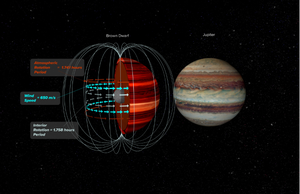 Zonal (latitudinal) winds dominate the bulk flow of planetary atmospheres. For gas giant planets such as Jupiter, the motion of clouds can be compared with radio emissions from the magnetosphere, which is connected to the planet’s interior, to determine the wind speed. In principle, this technique can be applied to brown dwarfs, the most common stellar type, and/or directly imaged exoplanets, if periods can be determined for the infrared and radio emissions. In this paper, the authors apply this method to measure the wind speeds on the 40MJ brown dwarf 2MASS J10475385+2124234. The difference between the radio period of 1.751 to 1.765 hours measured with the Jansky Very Large Array, and infrared period of 1.741 ± 0.007 hours measured with the Spitzer Space Telescope, implies a strong wind proceeding eastward of 650 ± 310 meters per second, 6X the winds on Jupiter. This could be due to atmospheric jet streams and/or low frictional drag at the bottom of the atmosphere.
Zonal (latitudinal) winds dominate the bulk flow of planetary atmospheres. For gas giant planets such as Jupiter, the motion of clouds can be compared with radio emissions from the magnetosphere, which is connected to the planet’s interior, to determine the wind speed. In principle, this technique can be applied to brown dwarfs, the most common stellar type, and/or directly imaged exoplanets, if periods can be determined for the infrared and radio emissions. In this paper, the authors apply this method to measure the wind speeds on the 40MJ brown dwarf 2MASS J10475385+2124234. The difference between the radio period of 1.751 to 1.765 hours measured with the Jansky Very Large Array, and infrared period of 1.741 ± 0.007 hours measured with the Spitzer Space Telescope, implies a strong wind proceeding eastward of 650 ± 310 meters per second, 6X the winds on Jupiter. This could be due to atmospheric jet streams and/or low frictional drag at the bottom of the atmosphere.
Figure caption: [Left] Brown dwarf and [Right] Jupiter. Artist's conception of brown dwarf illustrates magnetic field and atmosphere's top, which were observed at different wavelengths to determine wind speeds. Credit: Bill Saxton, NRAO/AUI/NSF.
Publication: Katelyn Allers (Bucknell University) et al., A Measurement of the Wind Speed on a Brown Dwarf, Science, 368, Issue 6487, 169 (10 April 2020).
NRAO Press Release: Astronomers Measure Wind Speed on a Brown Dwarf
The Lukewarm Chromosphere of Antares
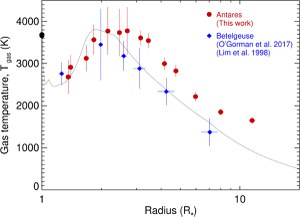 The authors present spatially resolved ALMA and Jansky VLA continuum observations of the early-M red supergiant Antares to search for the presence of a chromosphere at radio wavelengths. The free-free emission of the Antares atmosphere is resolved at 11 unique wavelengths between 0.7 mm (ALMA band 8) and 10 cm (VLA S band). The projected angular diameter is found to continually increase with increasing wavelength, from a low of 50.7 milli-arcseconds (mas) at 0.7 mm, up to a diameter of 431 mas at 10 cm, which corresponds to 1.35 and 11.6 times the photospheric angular diameter, respectively.
The authors present spatially resolved ALMA and Jansky VLA continuum observations of the early-M red supergiant Antares to search for the presence of a chromosphere at radio wavelengths. The free-free emission of the Antares atmosphere is resolved at 11 unique wavelengths between 0.7 mm (ALMA band 8) and 10 cm (VLA S band). The projected angular diameter is found to continually increase with increasing wavelength, from a low of 50.7 milli-arcseconds (mas) at 0.7 mm, up to a diameter of 431 mas at 10 cm, which corresponds to 1.35 and 11.6 times the photospheric angular diameter, respectively.
All four ALMA measurements show that the shape of the atmosphere is elongated, with a flattening of 15% at a similar position angle. The disk-averaged gas temperature of the atmosphere initially rises from a value of 2700 K at 1.35 R⋆ (i.e., 0.35 R⋆ above the photosphere) to a peak value of 3800 K at ∼2.5 R⋆, after which it then more gradually decreases to 1650 K at 11.6 R⋆. The rise in gas temperature between 1.35 R⋆ and ∼2.5 R⋆ is evidence for a chromospheric temperature rise above the photosphere of a red supergiant. The authors detect a clear change in the spectral index across the sampled wavelength range, with the flux density Sν∝ ν1.42 between 0.7 mm and 1.4 cm, which they associate with chromosphere-dominated emission, while the flux density Sν ∝ ν0.8 between 4.3 cm and 10 cm, which they associate with wind-dominated emission. The authors show that Antares’s outer atmosphere is transparent at their observed wavelengths, and the lukewarm chromosphere that was detected is thus real and not just an average of the cool molecular shell and hot ultraviolet emitting gas. We then perform nonlocal thermal equilibrium modeling of the far-ultraviolet radiation field of another early-M red supergiant, Betelgeuse, and find that an additional hot (i.e., > 7000 K) chromospheric photoionization component with a much smaller filling factor must also exist throughout the chromospheres of these stars.
Figure caption: Comparison of the temperature structure of the extended atmospheres of the early-M supergiants Antares and Betelgeuse. The filled red circles are the measurements summarized in this work for Antares, and the filled blue diamonds are the measurements for Betelgeuse from previous work. The gas temperature error bars include the uncertainty in absolute flux density scale. The overlapping filled black circles at R⋆ = 1 represent the photospheric effective temperatures of Antares and Betelgeuse. The solid black line is the temperature profile of the semiempirical model for the extended atmosphere of Betelgeuse discussed in this paper.
Publication: E. O’Gorman (Dublin Institute for Advanced Studies) et al., ALMA and VLA Reveal the Lukewarm Chromospheres of the Nearby Red Supergiant Antares and Betelgeuse, Astronomy & Astrophysics, 638, A65 (2019).
NRAO Press Release: Supergiant Atmosphere of Antares Revealed by Radio Telescopes
A Census of the Orion Protostars
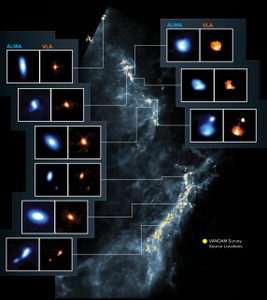 Tobin et al. conducted a survey of 328 protostars in the Orion molecular clouds with ALMA at 0.87 mm at a resolution of ~0.14 milli-arcseconds (40 AU), including observations with the Jansky VLA at 9 mm toward 148 protostars at a resolution of ~0.08 milli-arcseconds (32 AU). This is the largest multiwavelength survey of protostars at this resolution by an order of magnitude. The authors use the dust continuum emission at 0.87 and 9 mm to measure the dust disk radii and masses toward the Class 0, Class I, and flat-spectrum protostars, characterizing the evolution of these disk properties in the protostellar phase. The mean dust disk radii for the Class 0, Class I, and flat-spectrum protostars are 44+5.8−3.4, 37+4.9−3.0 and 28.5+3.7−2.3 AU, respectively, and the mean protostellar dust disk masses 25.9+7.7−4.0 , 14.9+3.8−2.2, and 11.6+3.5−1.9 M⊕, respectively. The decrease in dust disk masses is expected from disk evolution and accretion, but the decrease in disk radii may point to the initial conditions of star formation not leading to the systematic growth of disk radii or that radial drift is keeping the dust disk sizes small. At least 146 of these protostellar disks – 35% of 379 detected 0.87 mm continuum sources plus 42 nondetections – have disk radii greater than 50 AU. These properties are not found to vary significantly between different regions within Orion. The protostellar dust disk mass distributions are systematically larger than those of Class II disks by a factor of more than four, providing evidence that the cores of giant planets may need to at least begin their formation during the protostellar phase.
Tobin et al. conducted a survey of 328 protostars in the Orion molecular clouds with ALMA at 0.87 mm at a resolution of ~0.14 milli-arcseconds (40 AU), including observations with the Jansky VLA at 9 mm toward 148 protostars at a resolution of ~0.08 milli-arcseconds (32 AU). This is the largest multiwavelength survey of protostars at this resolution by an order of magnitude. The authors use the dust continuum emission at 0.87 and 9 mm to measure the dust disk radii and masses toward the Class 0, Class I, and flat-spectrum protostars, characterizing the evolution of these disk properties in the protostellar phase. The mean dust disk radii for the Class 0, Class I, and flat-spectrum protostars are 44+5.8−3.4, 37+4.9−3.0 and 28.5+3.7−2.3 AU, respectively, and the mean protostellar dust disk masses 25.9+7.7−4.0 , 14.9+3.8−2.2, and 11.6+3.5−1.9 M⊕, respectively. The decrease in dust disk masses is expected from disk evolution and accretion, but the decrease in disk radii may point to the initial conditions of star formation not leading to the systematic growth of disk radii or that radial drift is keeping the dust disk sizes small. At least 146 of these protostellar disks – 35% of 379 detected 0.87 mm continuum sources plus 42 nondetections – have disk radii greater than 50 AU. These properties are not found to vary significantly between different regions within Orion. The protostellar dust disk mass distributions are systematically larger than those of Class II disks by a factor of more than four, providing evidence that the cores of giant planets may need to at least begin their formation during the protostellar phase.
Figure caption: Herschel infrared image of the Orion Molecular Cloud [Insets] VLA 32 GHz and ALMA 250 GHz, sample images of protostars in the VANDAM sample.
Publication: John J. Tobin (National Radio Astronomy Observatory) et al., The VLA/ALMA Nascent Disk and Multiplicity (VANDAM) Survey of Orion Protostars. II. A Statistical Characterization of Class 0 and Class I Protostellar Disks, Astrophysical Journal, 890, 130 (20 February 2020).
NRAO Press Release: How Newborn Stars Prepare for the Birth of Planets
Megamaser Cosmology: A Better Hubble Constant
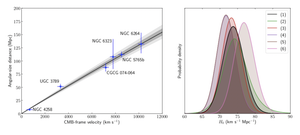 The authors present a measurement of the Hubble constant made using geometric distance measurements to megamaser-hosting galaxies. They have applied an improved approach for fitting maser data and obtained better distance estimates for four galaxies previously published by the Megamaser Cosmology Project: UGC 3789, NGC 6264, NGC 6323, and NGC 5765b. Combining these updated distance measurements with those for the maser galaxies CGCG 074-064 and NGC 4258, and assuming a fixed velocity uncertainty of 250 km s−1 associated with peculiar motions, this work constrains the Hubble constant to be H0 = 73.9 ± 3.0 km s−1 Mpc−1 independent of distance ladders and the cosmic microwave background. This best value relies solely on maser-based distance and velocity measurements, and it does not use any peculiar velocity corrections. Different approaches for correcting peculiar velocities do not modify H0 by more than ±1σ, with the full range of best-fit Hubble constant values spanning 71.8 – 76.9 km s−1 Mpc−1. The authors corroborate prior indications that the local value of H0 exceeds the early-Universe value, with a confidence level varying from 95% to 99% for different treatments of the peculiar velocities.
The authors present a measurement of the Hubble constant made using geometric distance measurements to megamaser-hosting galaxies. They have applied an improved approach for fitting maser data and obtained better distance estimates for four galaxies previously published by the Megamaser Cosmology Project: UGC 3789, NGC 6264, NGC 6323, and NGC 5765b. Combining these updated distance measurements with those for the maser galaxies CGCG 074-064 and NGC 4258, and assuming a fixed velocity uncertainty of 250 km s−1 associated with peculiar motions, this work constrains the Hubble constant to be H0 = 73.9 ± 3.0 km s−1 Mpc−1 independent of distance ladders and the cosmic microwave background. This best value relies solely on maser-based distance and velocity measurements, and it does not use any peculiar velocity corrections. Different approaches for correcting peculiar velocities do not modify H0 by more than ±1σ, with the full range of best-fit Hubble constant values spanning 71.8 – 76.9 km s−1 Mpc−1. The authors corroborate prior indications that the local value of H0 exceeds the early-Universe value, with a confidence level varying from 95% to 99% for different treatments of the peculiar velocities.
Figure caption: [Left] Distance to the megamaser galaxies. [Right] Probability distribution for H0 for the six galaxies.
Publication: D.W. Pesce (Harvard-Smithsonian Center for Astrophysics) et al., The Megamaser Cosmology Project. XIII. Combined Hubble Constant Constraints, Astrophysical Journal Letters, 891, L1 (1 March 2020).
NRAO Press Release: New Distance Measurements Bolster Challenge to Basic Model of Universe
A New Type of Cosmic Explosion
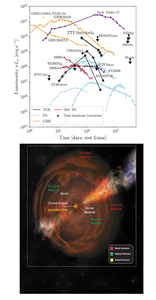 The authors discuss ZTF18abvkwla (the "Koala"), a fast blue optical transient (FBOT) discovered in the Zwicky Transient Facility (ZTF) One-Day Cadence (1DC) Survey. ZTF18abvkwla has features in common with the groundbreaking transient AT 2018cow: blue colors at peak light, a short rise time from half-max of under two days, a decay time to half-max of only three days, a high optical luminosity, a hot featureless spectrum at peak light, and a luminous radio counterpart. At late times (Dt > 80 days), the radio luminosity of ZTF18abvkwla at 10 GHz is most similar to that of long-duration gamma-ray bursts (GRBs). The host galaxy is a dwarf starburst galaxy (M ~ 5 x 108 M⊙ and SFR ~ 7 M⊙ per year) that is moderately metal-enriched (log[O/H] ~ 8.5), similar to the hosts of Gamma Ray Bursts (GRBs) and superluminous supernovae.
The authors discuss ZTF18abvkwla (the "Koala"), a fast blue optical transient (FBOT) discovered in the Zwicky Transient Facility (ZTF) One-Day Cadence (1DC) Survey. ZTF18abvkwla has features in common with the groundbreaking transient AT 2018cow: blue colors at peak light, a short rise time from half-max of under two days, a decay time to half-max of only three days, a high optical luminosity, a hot featureless spectrum at peak light, and a luminous radio counterpart. At late times (Dt > 80 days), the radio luminosity of ZTF18abvkwla at 10 GHz is most similar to that of long-duration gamma-ray bursts (GRBs). The host galaxy is a dwarf starburst galaxy (M ~ 5 x 108 M⊙ and SFR ~ 7 M⊙ per year) that is moderately metal-enriched (log[O/H] ~ 8.5), similar to the hosts of Gamma Ray Bursts (GRBs) and superluminous supernovae.
As in AT2018cow, the radio and optical emission in ZTF18abvkwla likely arises from two separate components: the radio from fast-moving ejecta and the optical from shock-interaction with confined dense material. These FBOTs likely begin the same way as certain supernovae and gamma-ray bursts. The differences are seen in the aftermath of the initial explosion. FBOTS are much brighter than supernovae, but not as bright as GRBs, suggesting a mildly relativistic jet engine in a dense environment. The authors find that transients in the FBOT rise-luminosity phase space are at least two to three orders of magnitude less common than core-collapse supernovae. They discuss strategies for identifying such events with future facilities such as the Vera C. Rubin Observatory, as well as prospects for detecting accompanying X-ray and radio emission.
Figure caption: [Top] Radio light curves for several cosmic explosion types. The Koala is marked with an arrow. The FBOTS (black stars) are all much brighter than supernovae, but not as bright as GRBs, suggesting a mildly relativistic jet engine in a dense environment. [Bottom] Artist’s impression of an FBOT.
Publication: Anna Ho (California Institute of Technology) et al., The Koala: A Fast Blue Optical Transient with Luminous Radio Emission from a Starburst Dwarf Galaxy at z=0.27, Astrophysical Journal, 895, 49 (26 May 2020).
NRAO Press Release: Astronomers Discover New Class of Cosmic Explosions
Finding the Youngest Radio Jets
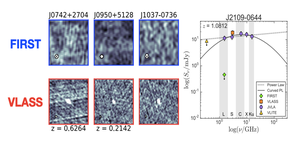 The authors present new sub-arcsecond Jansky Very Large Array (VLA) imaging at 10 GHz of 155 ultra-luminous (Lbol∼1011.7−14.2L⊙) and heavily obscured quasars with redshifts z ∼ 0.4−3. The sample was selected to have extremely red mid-infrared to optical color ratios based on data from the Wide-Field Infrared Survey Explorer (WISE) along with a detection of bright, unresolved radio emission from the NRAO VLA Sky Survey (NVSS) or Faint Images of the Radio Sky at Twenty-Centimeters (FIRST) Survey. High-resolution VLA observations have revealed that the majority of the sources in this sample (93 of 155) are compact on angular scales < 0.2 arcseconds (≤ 1.7 kpc at z ∼ 2). The radio luminosities, linear extents, and lobe pressures of these sources are similar to young radio active galactic nuclei (AGN) but their space density is considerably lower. Application of a simple adiabatic lobe expansion model suggests relatively young dynamical ages (∼104−7 years), relatively high ambient interstellar medium densities (∼1−104 cm−3), and modest lobe expansion speeds (∼30−10,000 km s−1). The authors find their sources to be consistent with a population of newly-triggered, young jets caught in a unique evolutionary stage in which they still reside within the dense gas reservoirs of their hosts. Based on their radio luminosity function and dynamical ages, the authors estimate only ∼20% of classical large scale FRI/II radio galaxies could have evolved directly from these objects. They speculate that the WISE-NVSS sources might first become Gigahertz Peaked Spectrum or Compact Steep Spectrum sources, of which some might ultimately evolve into larger radio galaxies.
The authors present new sub-arcsecond Jansky Very Large Array (VLA) imaging at 10 GHz of 155 ultra-luminous (Lbol∼1011.7−14.2L⊙) and heavily obscured quasars with redshifts z ∼ 0.4−3. The sample was selected to have extremely red mid-infrared to optical color ratios based on data from the Wide-Field Infrared Survey Explorer (WISE) along with a detection of bright, unresolved radio emission from the NRAO VLA Sky Survey (NVSS) or Faint Images of the Radio Sky at Twenty-Centimeters (FIRST) Survey. High-resolution VLA observations have revealed that the majority of the sources in this sample (93 of 155) are compact on angular scales < 0.2 arcseconds (≤ 1.7 kpc at z ∼ 2). The radio luminosities, linear extents, and lobe pressures of these sources are similar to young radio active galactic nuclei (AGN) but their space density is considerably lower. Application of a simple adiabatic lobe expansion model suggests relatively young dynamical ages (∼104−7 years), relatively high ambient interstellar medium densities (∼1−104 cm−3), and modest lobe expansion speeds (∼30−10,000 km s−1). The authors find their sources to be consistent with a population of newly-triggered, young jets caught in a unique evolutionary stage in which they still reside within the dense gas reservoirs of their hosts. Based on their radio luminosity function and dynamical ages, the authors estimate only ∼20% of classical large scale FRI/II radio galaxies could have evolved directly from these objects. They speculate that the WISE-NVSS sources might first become Gigahertz Peaked Spectrum or Compact Steep Spectrum sources, of which some might ultimately evolve into larger radio galaxies.
Figure caption: [Left] VLA Sky Survey and FIRST images of the emerging radio loud quasar population. [Right] VLA spectrum of one source showing the flat radio spectrum.
Publication: Pallavi Patil (University of Virginia) et al., High-resolution VLA Imaging of Obscured Quasars: Young Radio Jets Caught in a Dense ISM, Astrophysical Journal, 896, 18 (9 June 2020).
A Massive Rotating Disk in the Early Universe
 Massive disk galaxies like the Milky Way are expected to form at late times in traditional models of galaxy formation, but recent numerical simulations suggest that such galaxies could form as early as a billion years after the Big Bang through the accretion of cold material and mergers. Observationally, it has been difficult to identify disk galaxies in emission at high redshift to discern between competing models of galaxy formation. In this contribution, the authors report imaging, with a resolution of ~1.3 kiloparsecs, the 158-micrometre emission line from singly ionized carbon, the far-infrared dust continuum, and the near-ultraviolet continuum emission from a galaxy at a redshift of 4.2603, identified by detecting its absorption of quasar light. These observations show that the emission arises from gas inside a cold, dusty, rotating disk with a rotational velocity of ~ 272 kilometers per second. The detection of emission from carbon monoxide in the galaxy yields a molecular mass that is consistent with the estimate from the ionized carbon emission of ~ 72 billion M⊙. The existence of such a massive, rotationally supported, cold disk galaxy when the Universe was only 1.5 billion years old favors formation through either cold-mode accretion or mergers, although its large rotational velocity and large content of cold gas remain challenging to reproduce with most numerical simulations.
Massive disk galaxies like the Milky Way are expected to form at late times in traditional models of galaxy formation, but recent numerical simulations suggest that such galaxies could form as early as a billion years after the Big Bang through the accretion of cold material and mergers. Observationally, it has been difficult to identify disk galaxies in emission at high redshift to discern between competing models of galaxy formation. In this contribution, the authors report imaging, with a resolution of ~1.3 kiloparsecs, the 158-micrometre emission line from singly ionized carbon, the far-infrared dust continuum, and the near-ultraviolet continuum emission from a galaxy at a redshift of 4.2603, identified by detecting its absorption of quasar light. These observations show that the emission arises from gas inside a cold, dusty, rotating disk with a rotational velocity of ~ 272 kilometers per second. The detection of emission from carbon monoxide in the galaxy yields a molecular mass that is consistent with the estimate from the ionized carbon emission of ~ 72 billion M⊙. The existence of such a massive, rotationally supported, cold disk galaxy when the Universe was only 1.5 billion years old favors formation through either cold-mode accretion or mergers, although its large rotational velocity and large content of cold gas remain challenging to reproduce with most numerical simulations.
Figure caption: [Far left & left center] VLA CO contours, and ALMA contours of the [CII] and thermal dust emission from the z=4.3 Wolfe galaxy. [Right center & far right]: [CII] velocity field, and the rotation curve.
Publication: Marcel Neeleman (Max Planck Institute for Astronomy) et al., A Cold, Massive, Rotating Disk Galaxy 1.5 Billion Years after the Big Bang, Nature, 581, 269 (20 May 2020).
NRAO Press Release: ALMA Discovers Massive Rotating Disk in Early Universe
VLBA Measures the Ephemeris of Saturn
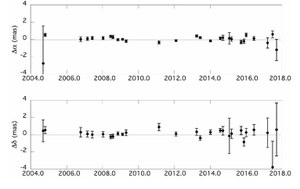 Jones et al. report results from multi-epoch radio astrometry of the Cassini spacecraft with the Very Long Baseline Array (VLBA). These observations are part of a program to determine accurate positions for the Saturn system barycenter in the inertial International Celestial Reference Frame (ICRF) and to use these position measurements to improve our knowledge of Saturn's orbit in the planetary ephemeris. The VLBA observations reported here cover the full duration of the orbital phase of the Cassini mission, from Saturn orbit insertion in 2004 to the end of mission in 2017. This period covers more than one-third of Saturn's orbital period, allowing the team to obtain good orbit constraints for Saturn, particularly on the inclination and ascending node longitude. During the early years of Cassini's orbital mission, their VLBA data dominated the determination of orbit orientation, while later in the mission range measurements become more significant. The orientation of Saturn's orbit is now known to ~ 0.25 milli-arcseconds (1.25 nrad), an order of magnitude improvement since the start of Cassini observations. Continuing improvements in the ICRF position accuracy for the phase reference sources, and possible improvements in the final orbit solutions for Cassini, may lead to a still better Saturn orbit over the coming years.
Jones et al. report results from multi-epoch radio astrometry of the Cassini spacecraft with the Very Long Baseline Array (VLBA). These observations are part of a program to determine accurate positions for the Saturn system barycenter in the inertial International Celestial Reference Frame (ICRF) and to use these position measurements to improve our knowledge of Saturn's orbit in the planetary ephemeris. The VLBA observations reported here cover the full duration of the orbital phase of the Cassini mission, from Saturn orbit insertion in 2004 to the end of mission in 2017. This period covers more than one-third of Saturn's orbital period, allowing the team to obtain good orbit constraints for Saturn, particularly on the inclination and ascending node longitude. During the early years of Cassini's orbital mission, their VLBA data dominated the determination of orbit orientation, while later in the mission range measurements become more significant. The orientation of Saturn's orbit is now known to ~ 0.25 milli-arcseconds (1.25 nrad), an order of magnitude improvement since the start of Cassini observations. Continuing improvements in the ICRF position accuracy for the phase reference sources, and possible improvements in the final orbit solutions for Cassini, may lead to a still better Saturn orbit over the coming years.
Figure caption: Post-fit residuals of Saturn’s orbit fit to the VLBA determined position for the Saturn system barycenter, in right ascension and declination.
Publication: Dayton L. Jones (Space Science Institute) et al., Very Long Baseline Array Astrometry of Cassini: The Final Epochs and an Improved Orbit of Saturn, Astronomical Journal, 159, 75 (20 January 2020).
Large-scale Gas Distribution Around Protoplanetary Disks
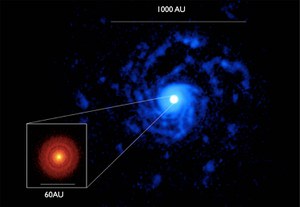 While protoplanetary disks often appear to be compact and well organized in millimeter continuum emission, CO spectral line observations are increasingly revealing complex behavior at large distances from the host star. Huang et al. present deep ALMA maps of the J = 2−1 transition of 12CO, 13CO, and C18O, as well as the J = 3−2 transition of DCO+, toward the T Tauri star RU Lup at a resolution of ~0.3 arcseconds (~50 AU). The CO isotopologue emission traces four major components of the RU Lup system: (1) a compact Keplerian disk with a radius of ~120 AU; (2) a non-Keplerian "envelope-like" structure surrounding the disk and extending to ~260 AU from the star; (3) at least five blueshifted spiral arms stretching up to 1000 AU; and (4) clumps outside the spiral arms located up to 1500 AU in projection from RU Lup. The authors comment on potential explanations for RU Lup's peculiar gas morphology, including gravitational instability, accretion of material onto the disk, or perturbation by another star. RU Lup's extended non-Keplerian CO emission, elevated stellar accretion rate, and unusual photometric variability suggest that it could be a scaled-down Class II analog of the outbursting FU Ori systems.
While protoplanetary disks often appear to be compact and well organized in millimeter continuum emission, CO spectral line observations are increasingly revealing complex behavior at large distances from the host star. Huang et al. present deep ALMA maps of the J = 2−1 transition of 12CO, 13CO, and C18O, as well as the J = 3−2 transition of DCO+, toward the T Tauri star RU Lup at a resolution of ~0.3 arcseconds (~50 AU). The CO isotopologue emission traces four major components of the RU Lup system: (1) a compact Keplerian disk with a radius of ~120 AU; (2) a non-Keplerian "envelope-like" structure surrounding the disk and extending to ~260 AU from the star; (3) at least five blueshifted spiral arms stretching up to 1000 AU; and (4) clumps outside the spiral arms located up to 1500 AU in projection from RU Lup. The authors comment on potential explanations for RU Lup's peculiar gas morphology, including gravitational instability, accretion of material onto the disk, or perturbation by another star. RU Lup's extended non-Keplerian CO emission, elevated stellar accretion rate, and unusual photometric variability suggest that it could be a scaled-down Class II analog of the outbursting FU Ori systems.
Figure caption: ALMA CO 2-1 (blue) and 230 GHz dust (red) emission at 0.3 arcsec resolution of the protoplanetary disk around RU Lupus.
Publication: Jane Huang et al.. Large-scale CO Spiral Arms and Complex Kinematics Associated with the T Tauri Star RU Lup, Astrophysical Journal, 898, 140 (3 August 2020).
NRAO Press Release: ALMA Captures Stirred-Up Planet Factory
First astrometric planet discovery using VLBI
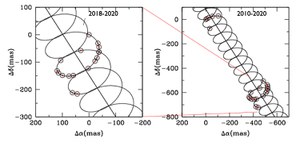 Astrometric observations of the M9 dwarf TVLM 513–46546 taken with the VLBA reveal an astrometric signature consistent with a period of 221 ± 5 days. The orbital fit implies that the companion has a mass mp = 0.35−0.42 MJ, a circular orbit (e ~ 0), a semimajor axis a = 0.28−0.31 AU, and an inclination angle i = 71°−88°. The detected companion, TVLM 513b, is one of the few giant-mass planets found associated with ultracool dwarfs. The presence of a Saturn-like planet on a circular orbit 0.3 AU from a 0.06−0.08 M ⊙ star represents a challenge to planet formation theory. This is the first astrometric detection of a planet at radio wavelengths.
Astrometric observations of the M9 dwarf TVLM 513–46546 taken with the VLBA reveal an astrometric signature consistent with a period of 221 ± 5 days. The orbital fit implies that the companion has a mass mp = 0.35−0.42 MJ, a circular orbit (e ~ 0), a semimajor axis a = 0.28−0.31 AU, and an inclination angle i = 71°−88°. The detected companion, TVLM 513b, is one of the few giant-mass planets found associated with ultracool dwarfs. The presence of a Saturn-like planet on a circular orbit 0.3 AU from a 0.06−0.08 M ⊙ star represents a challenge to planet formation theory. This is the first astrometric detection of a planet at radio wavelengths.
Figure caption: Proper motion of the star TVLM 513–46546 showing the astrometric wobble due to the presence of the planet.
Publication: Salvator Curiel (Universidad Nacional Autonoma de México) et al., An astrometric planetary companion candidate to the M9 Dwarf TVLM 513-46546, Astronomical Journal, 159, 72 (4 August 2020).
NRAO Press Release: VLBA Finds Planet Orbiting Small, Cool Star
Misaligned Rings in a Protoplanetary Disk
 Independent research teams have used ALMA and the Very Large Telescope (VLT) to image a set of misaligned rings in a protoplanetary disk around the young, triple star system GW Orionis. This system includes an inner binary of 1 AU separation, and an outer star orbiting at 8 AU, with a different orbital plane. Young stars are surrounded by a circumstellar disk of gas and dust, within which planet formation can occur. Gravitational forces in multiple star systems can disrupt such a disk.
Independent research teams have used ALMA and the Very Large Telescope (VLT) to image a set of misaligned rings in a protoplanetary disk around the young, triple star system GW Orionis. This system includes an inner binary of 1 AU separation, and an outer star orbiting at 8 AU, with a different orbital plane. Young stars are surrounded by a circumstellar disk of gas and dust, within which planet formation can occur. Gravitational forces in multiple star systems can disrupt such a disk.
GW Orionis is a hierarchical triple system with a rare circumtriple disk. Bi et al present ALMA observations of 1.3 mm dust continuum and 12CO J = 2 − 1 molecular gas emission of the disk. For the first time, three dust rings are identified in the GW Ori disk at ~46, 188, and 338 AU, with estimated dust mass of 74, 168, and 245 Earth masses, respectively. The outermost ring is apparently the largest dust ring ever found in protoplanetary disks. The authors use visibility modeling of their dust continuum data to show that the disk has misaligned parts, and the innermost dust ring is eccentric. The disk misalignment is also suggested by the CO kinematics. These substructures are interpreted as evidence of ongoing dynamical interactions between the triple stars and the circumtriple disk.
Theoretical models predict that if a circumstellar disk is misaligned with the orbital plane of the stars, the disk should warp and break into precessing rings, a phenomenon known as disk tearing. Kraus et al. present ALMA and VLT observations of the triple-star system GW Orionis, and find evidence for such disk tearing. These authors imaged the GW Orionis system using submillimeter and near-infrared interferometry, which trace thermal dust emission, and using visible and near-infrared adaptive-optics imaging polarimetry at the VLT, which trace scattered light. These data allow enable Kraus et al. to constrain the dust distribution in the system. Their images show an eccentric ring that is misaligned with the orbital planes and the outer disk. The ring casts shadows on a strongly warped intermediate region of the disk. If planets can form within the warped disk, disk tearing could provide a mechanism for forming wide-separation planets on oblique orbits.
Figure caption: ALMA 230GHz (left) and VLT (center) images of the misaligned protoplanetary disk around the young triple star system GW Orionis (Bi et al. 2020, Kraus et al. 2020). (right) The 3D model of the GW Orionis system, in projection.
Publications:
Jiaquing Bi (University of Victoria) et al., GW Ori: Interactions between a Triple-star System and Its Circumtriple Disk in Action, Astronomical Journal, 159, 72 (4 August 2020).
Stefan Kraus (University of Exeter) et al., A triple-star system with a misaligned and warped circumstellar disk shaped by disk tearing, Science, 369, 1233 (4 September 2020).
NRAO Press Release: ALMA Discovers Misaligned Rings in Planet-Forming Disk Around Triple Stars
The Distance to a Magnetar
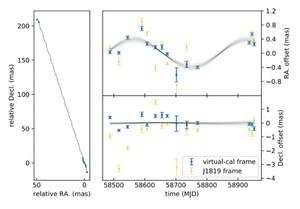 XTE J1810−197 (J1810) was the first magnetar identified to emit radio pulses, and has been extensively studied during a radio-bright phase in 2003–2008. Magnetars are slowly rotating neutron stars with the largest magnetic fields measured in the Universe (> 1014 Gauss). The magnetar J1810 is estimated to be relatively nearby compared to other Galactic magnetars, and provides a useful prototype for the physics of high magnetic fields, magnetar velocities, and the plausible connection to extragalactic fast radio bursts.
XTE J1810−197 (J1810) was the first magnetar identified to emit radio pulses, and has been extensively studied during a radio-bright phase in 2003–2008. Magnetars are slowly rotating neutron stars with the largest magnetic fields measured in the Universe (> 1014 Gauss). The magnetar J1810 is estimated to be relatively nearby compared to other Galactic magnetars, and provides a useful prototype for the physics of high magnetic fields, magnetar velocities, and the plausible connection to extragalactic fast radio bursts.
Upon the rebrightening of the magnetar at radio wavelengths in late 2018, Ding et al. resumed an astrometric campaign on J1810 with the VLBA, and sampled 14 new positions of J1810 over 1.3 yr. The phase calibration for the new observations was performed with two-phase calibrators that are quasi-colinear on the sky with J1810, enabling substantial improvement of the resultant astrometric precision. Combining their new observations with two archival observations from 2006, they refined the proper motion and reference position of the magnetar and have measured its annual geometric parallax, the first such measurement for a magnetar.
The parallax of 0.40 ± 0.05 milli-arcseconds corresponds to a most probable distance 2.5+0.4−0.3 kpc for J1810. Their new astrometric results confirm an unremarkable transverse peculiar velocity of ≈200 km/sec for J1810, which is only at the average level among the pulsar population. The magnetar proper motion vector points back to the central region of a supernova remnant (SNR) at a compatible distance at ≈70 kyr ago, but a direct association is disfavored by the estimated SNR age of ∼3 kyr
Figure caption: Astrometric observations at 5.7 GHz with the VLBA, showing the proper motion relative to the phase reference source, and the annual parallax after subtraction of the proper motion, of XTE J1810.
Publication: Hoa Ding (Swinburne University of Technology) et al., A Magnetar Parallax, Monthly Notices of the Royal Astronomical Society, 498, 3736 (November 2020).
NRAO Press Release: VLBA Makes First Direct Distance Measurement to Magnetar
Axions, Magnetars, and the VLA
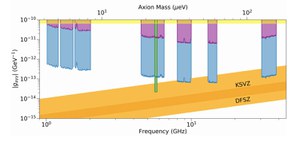 Axions are a leading candidate for cold Dark Matter. Axions may convert their rest energy into photons in extreme magnetic field regions, such as the > 1014 G fields that exist around Magnetars – the strongest fields known in the Universe. Such conversion would produce photons in the range of 0.2 GHz to 20 GHz.
Axions are a leading candidate for cold Dark Matter. Axions may convert their rest energy into photons in extreme magnetic field regions, such as the > 1014 G fields that exist around Magnetars – the strongest fields known in the Universe. Such conversion would produce photons in the range of 0.2 GHz to 20 GHz.
In this paper, PI Jeremy Darling reports on a search for dark matter axion conversion photons from the magnetosphere of the Galactic Center magnetar PSR J1745-2900 using spectra obtained from the Karl G. Jansky VLA. No significant spectral features are detected. Using a hybrid model for PSR J1745-2900 and canonical assumptions about the dark matter density profile, Darling could exclude axion models with axion-photon coupling gaγγ > 6–34×10−12 GeV−1 with 95% confidence over the mass ranges 4.2–8.4, 18.6–26.9, 33.0–41.4, 53.7–62.1, and 126.0–159.3 μeV. If there is a dark matter cusp, the limits reduce to gaγγ > 6–34×10−14 GeV−1, which overlap some axion models for the observed mass ranges >33 μeV. These limits may be improved by modeling the stimulated emission that can boost the axion-photon conversion process. The radio non-detection provides one of the best limits to date on the Axion-photon coupling constant.
Figure caption: Limits on the Axion-photon coupling constant from the VLA in PSR J1745-2900). Yellow regions are current models for the Axion magnetic coupling constant for a reasonable range in Axion mass. The green box indicates the best laboratory limits to date.
Publication: Jeremy Darling (University of Colorado), Search for Axionic Dark Matter Using the Magnetar PSR J1745-2900, Physics Review Letters, 125, 121103 (17 September 2020).
Imaging the Accretion Zone in M87
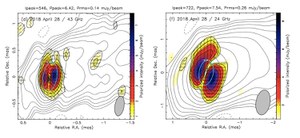 Kravchenko et al. report on high angular resolution polarimetric observations of the nearby radio galaxy M87 using the VLBA at 24 GHz (λ = 1.3 cm) and 43 GHz (λ = 7 mm) in 2017–2018. New images of the linear polarization substructure in the nuclear region are presented, characterized by a two-component pattern of polarized intensity and smooth rotation of the polarization plane around the 43 GHz core. From a comparison with an analogous dataset from 2007, the authors find that this global polarization pattern remains stable over a time interval of 11 years, while showing smaller month-scale variability. The authors discuss the possible Faraday rotation toward the M87 nucleus at centimeter to millimeter wavelengths. These results can be interpreted in a scenario where the observed polarimetric pattern is associated with the magnetic structure in the confining magnetohydrodynamic wind, which also serves as the source of the observed Faraday rotation.
Kravchenko et al. report on high angular resolution polarimetric observations of the nearby radio galaxy M87 using the VLBA at 24 GHz (λ = 1.3 cm) and 43 GHz (λ = 7 mm) in 2017–2018. New images of the linear polarization substructure in the nuclear region are presented, characterized by a two-component pattern of polarized intensity and smooth rotation of the polarization plane around the 43 GHz core. From a comparison with an analogous dataset from 2007, the authors find that this global polarization pattern remains stable over a time interval of 11 years, while showing smaller month-scale variability. The authors discuss the possible Faraday rotation toward the M87 nucleus at centimeter to millimeter wavelengths. These results can be interpreted in a scenario where the observed polarimetric pattern is associated with the magnetic structure in the confining magnetohydrodynamic wind, which also serves as the source of the observed Faraday rotation.
Figure caption: VLBA images at 43 GHz (left) and 24 GHz (right) of the polarized (color) and total (gray contours) intensity from M87, plus observed position angles.
Publication: E. Kravchenko (Istituto di Radioastronomia, Lebedev Physical Institute) et al., Linear polarization in the nucleus of M87 at 7 mm and 1.3 cm, Astronomy & Astrophysics, 637, L6 (May 2020).
The ALMA Spectroscopic Survey Deep Field
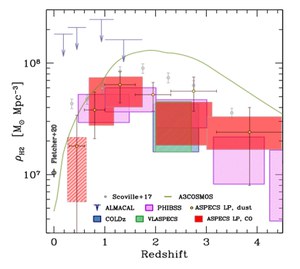 Decarli et al. present a CO and atomic fine-structure line luminosity function analysis using the ALMA Spectroscopic Survey in the Hubble Ultra Deep Field (ASPECS). ASPECS consists of two spatially– overlapping mosaics that cover the entire ALMA 3 mm and 1.2 mm bands. We combine the results of a line candidate search of the 1.2 mm data cube with those previously obtained from the 3 mm cube. The resulting analysis shows that ∼80% of the line flux observed at 3 mm arises from CO(2-1) or CO(3-2) emitters at z=1–3 (‘cosmic noon’). At 1.2mm, more than half of the line flux arises from intermediate-J CO transitions (Jup=3–6); ∼ 12% from neutral Carbon lines; and < 1% from singly-ionized Carbon, [C II]. This implies that future [C II] intensity mapping surveys in the epoch of reionization will need to account for a highly significant CO foreground. The CO luminosity functions probed at 1.2mm show a decrease in the number density at a given line luminosity at increasing Jup and redshift. Comparisons between the CO luminosity functions for different CO transitions at a fixed redshift reveal sub-thermal conditions on average in galaxies up to z ∼ 4. In addition, the comparison of the CO luminosity functions for the same transition at different redshifts reveals that the evolution is not driven by excitation. The cosmic density of molecular gas in galaxies, rH2 shows a redshift evolution with an increase from high redshift up to z ∼ 1.5 followed by a factor ∼ 6 drop down to the present day. This is in qualitative agreement with the evolution of the cosmic star–formation rate density, suggesting that the molecular gas depletion time is approximately constant with redshift, after averaging over the star-forming galaxy population.
Decarli et al. present a CO and atomic fine-structure line luminosity function analysis using the ALMA Spectroscopic Survey in the Hubble Ultra Deep Field (ASPECS). ASPECS consists of two spatially– overlapping mosaics that cover the entire ALMA 3 mm and 1.2 mm bands. We combine the results of a line candidate search of the 1.2 mm data cube with those previously obtained from the 3 mm cube. The resulting analysis shows that ∼80% of the line flux observed at 3 mm arises from CO(2-1) or CO(3-2) emitters at z=1–3 (‘cosmic noon’). At 1.2mm, more than half of the line flux arises from intermediate-J CO transitions (Jup=3–6); ∼ 12% from neutral Carbon lines; and < 1% from singly-ionized Carbon, [C II]. This implies that future [C II] intensity mapping surveys in the epoch of reionization will need to account for a highly significant CO foreground. The CO luminosity functions probed at 1.2mm show a decrease in the number density at a given line luminosity at increasing Jup and redshift. Comparisons between the CO luminosity functions for different CO transitions at a fixed redshift reveal sub-thermal conditions on average in galaxies up to z ∼ 4. In addition, the comparison of the CO luminosity functions for the same transition at different redshifts reveals that the evolution is not driven by excitation. The cosmic density of molecular gas in galaxies, rH2 shows a redshift evolution with an increase from high redshift up to z ∼ 1.5 followed by a factor ∼ 6 drop down to the present day. This is in qualitative agreement with the evolution of the cosmic star–formation rate density, suggesting that the molecular gas depletion time is approximately constant with redshift, after averaging over the star-forming galaxy population.
Figure caption: Evolution of the molecular gas density of the Universe derived from ASPECS and other methods.
Publication: Roberto Decarli (Istituto di Radioastronomia) et al., The ALMA Spectroscopic Survey in the HUDF: Multi-band constraints on line luminosity functions and the cosmic density of molecular gas, Astrophysical Journal (submitted 2020).




Connect with NRAO